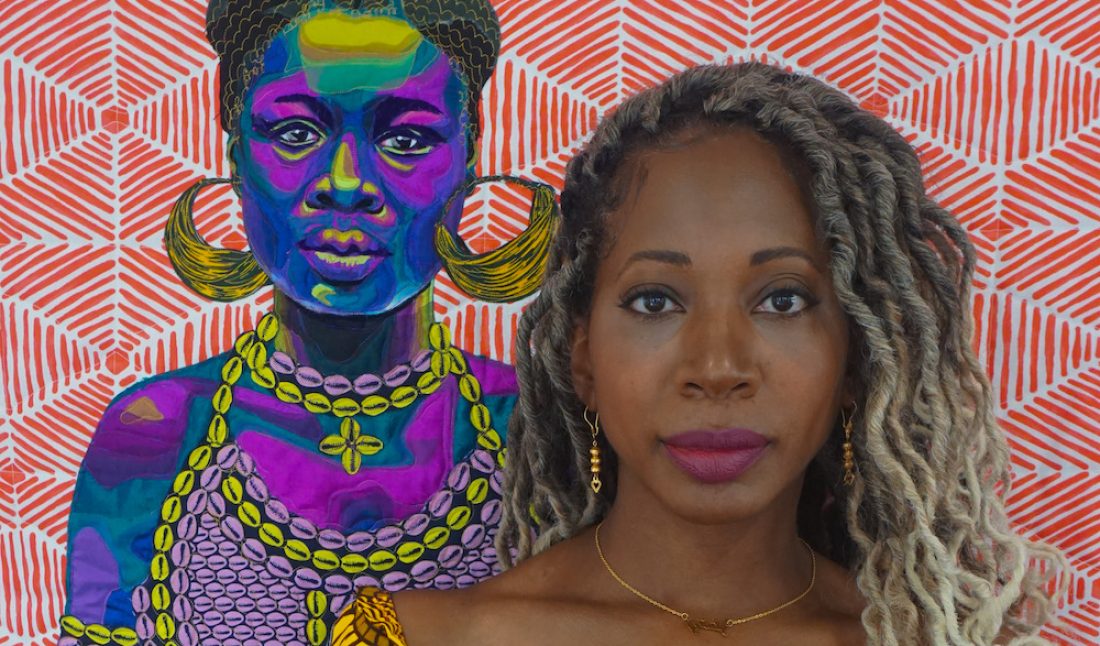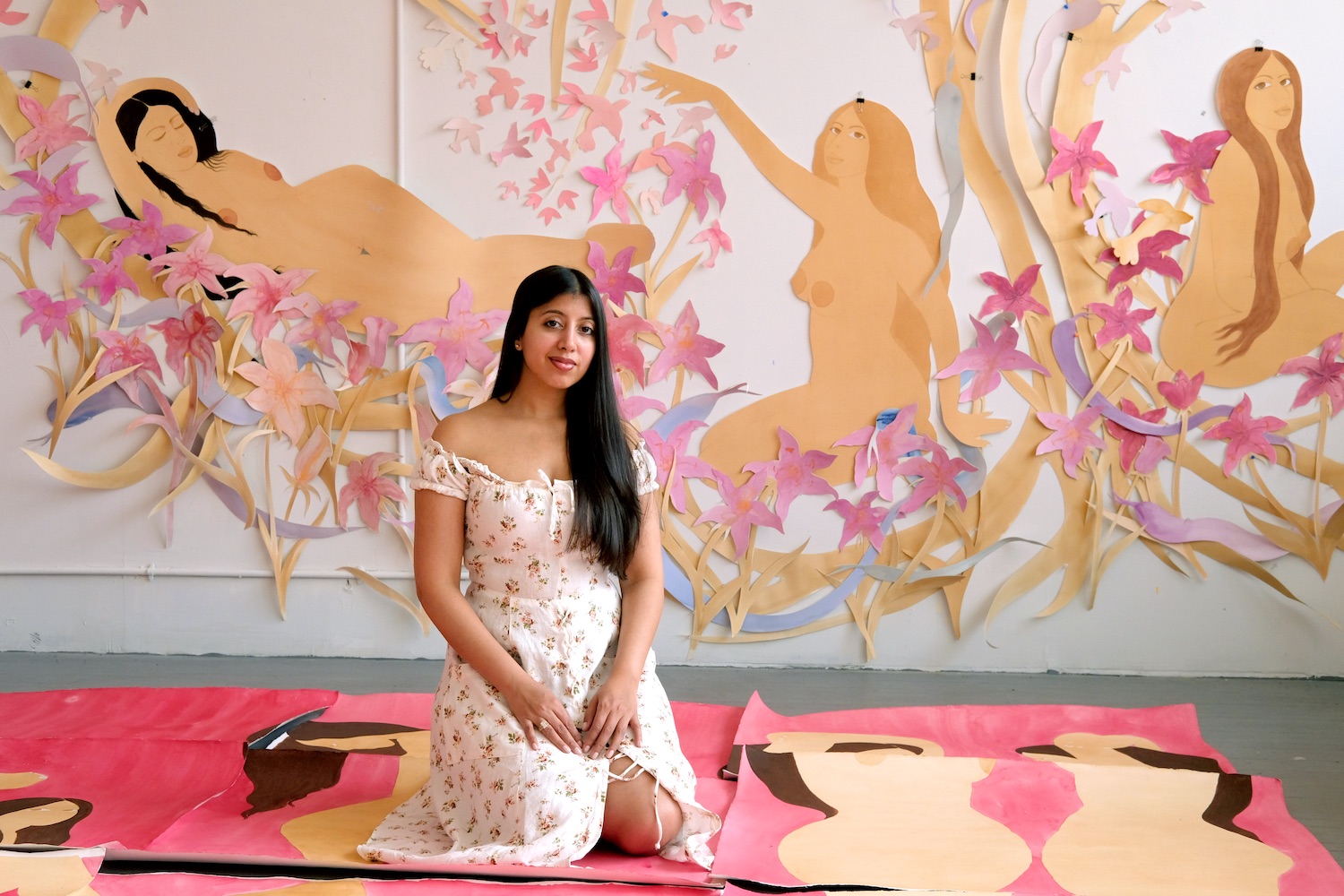Bisa Butler is on a mission to tell the stories of those who have been forgotten, passed over, and lost to time. Using vibrant African prints and fabrics, she quilts life-size portraits of Black people with something to say, whether history has taken the time to listen or not.
Her recent solo show with Claire Oliver Gallery, “The Storm, the Whirlwind and the Earthquake,” stemmed from archival photographs of African Americans during World War II, commissioned by the U.S. Government Farm Securities Administration. These subjects, mostly unidentified, never shown their captured image, stare back at the viewer, challenging your pity, asking, “And what about you? What have you done with your life?”
Butler spends over a hundred hours on each quilted work, and her imagined narrative and conversation with her subjects grow into an emotional connection that emanates from the finished piece.
Whitewall spoke with Butler, whose solo show “Bisa Butler: Portraits” at the Art Institute of Chicago opens in November.
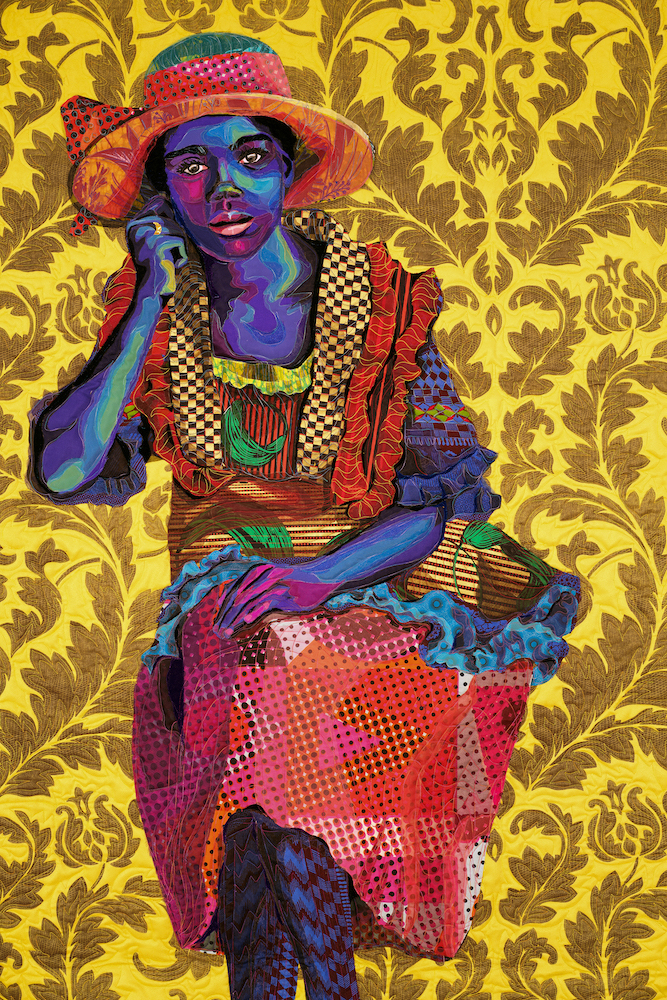 Bisa Butler, “Daughter Of The Dust,” 2020, cotton, silk, wool and velvet quilted and appliqué, 58 x 83 x 2 inches, courtesy of the artist and Claire Oliver Gallery.
Bisa Butler, “Daughter Of The Dust,” 2020, cotton, silk, wool and velvet quilted and appliqué, 58 x 83 x 2 inches, courtesy of the artist and Claire Oliver Gallery.
WHITEWALL: How are you doing? Have you been able to make work during this season of compounded crises?
BISA BUTLER: I’ve always worked from home. I took over the dining room, and I have another room with my machine. My day to day hasn’t really changed, but psychologically, especially with the racial tensions and unrest, it’s causing me to be extremely distracted. It is definitely having an effect on my work.
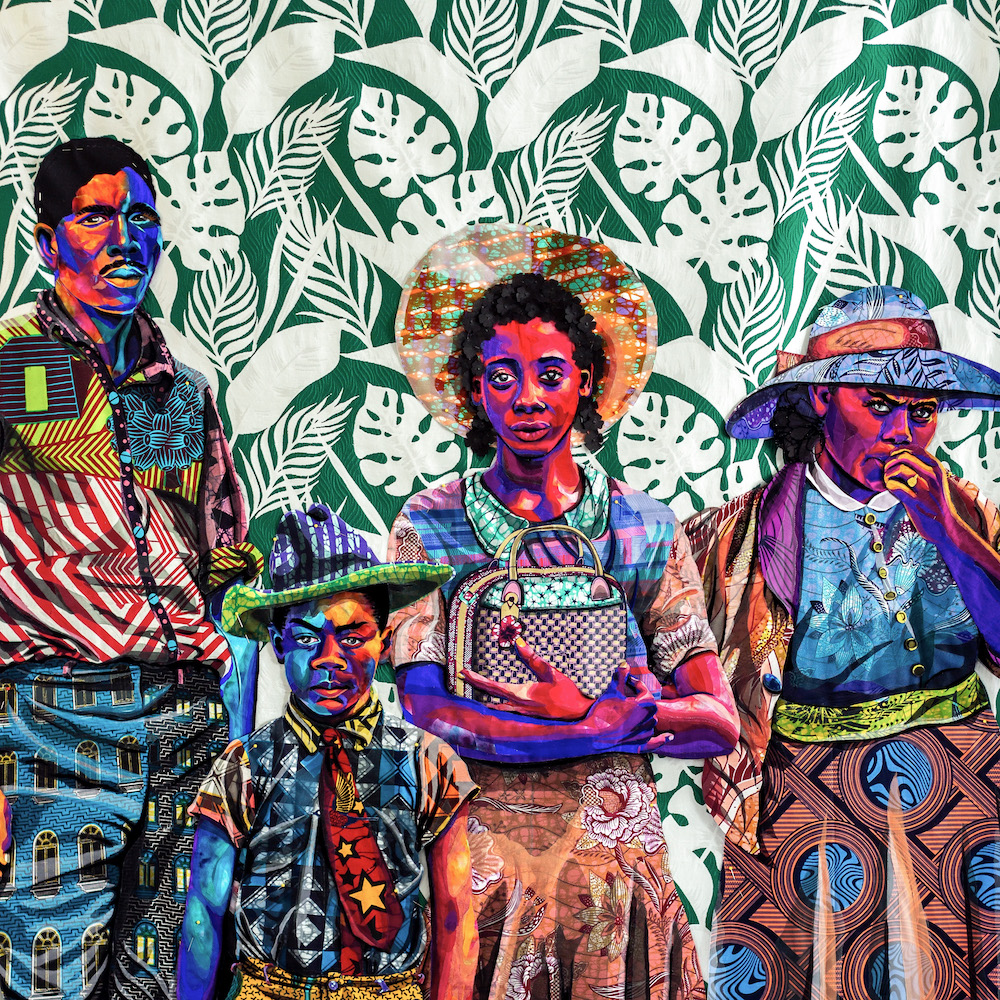 Bisa Butler, “The Warmth of Other Sons” (detail), 2020, a multi-figure portrait of a migrant family, cotton, silk, wool, and velvet, 10 feet x 12 feet, courtesy of the artist and Claire Oliver Gallery.
Bisa Butler, “The Warmth of Other Sons” (detail), 2020, a multi-figure portrait of a migrant family, cotton, silk, wool, and velvet, 10 feet x 12 feet, courtesy of the artist and Claire Oliver Gallery.
I always had this idea that I want to speak for my people, amplify who Black people are. But now it’s so much more critical that I have to be more careful about what I put out there. It’s like, well now that I have your attention, let’s talk about Breonna Taylor.
WW: We read that you introduced quilting into your practice after having your child, realizing that you could work that way while being a mother at home. How did you start working with fabric?
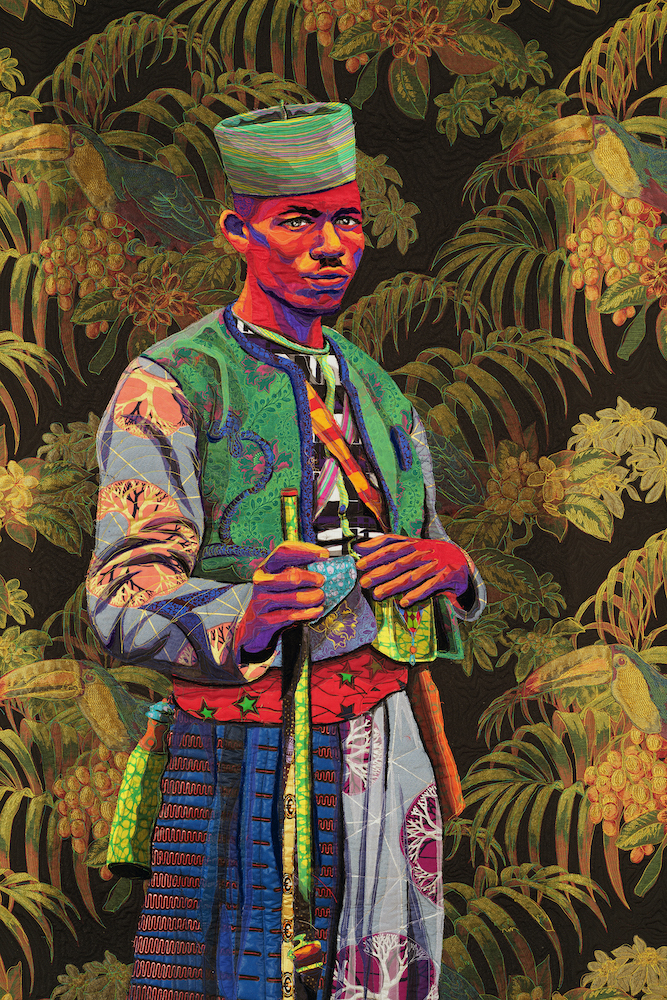 Bisa Butler, “Zouave,” 2020, cotton, silk, wool, and velvet quilted and appliqué, 54 x 88 x 2 inches, courtesy of the artist and Claire Oliver Gallery.
Bisa Butler, “Zouave,” 2020, cotton, silk, wool, and velvet quilted and appliqué, 54 x 88 x 2 inches, courtesy of the artist and Claire Oliver Gallery.
BB: I got pregnant when I was about to graduate. Suddenly, I had this baby on the way and my boyfriend had just graduated. We said, let’s put our plans on hyperdrive, get married, move in together—and art got left behind, in a way. I couldn’t even smell paint. The scent of it was instant nausea.
After a few years, when she was about two, I decided to go to grad school. I thought, “I can teach art and that will fulfill my desire to make art. My schedule would be conducive to that of a mother.” But I still didn’t think that I could make my own artwork, not really.
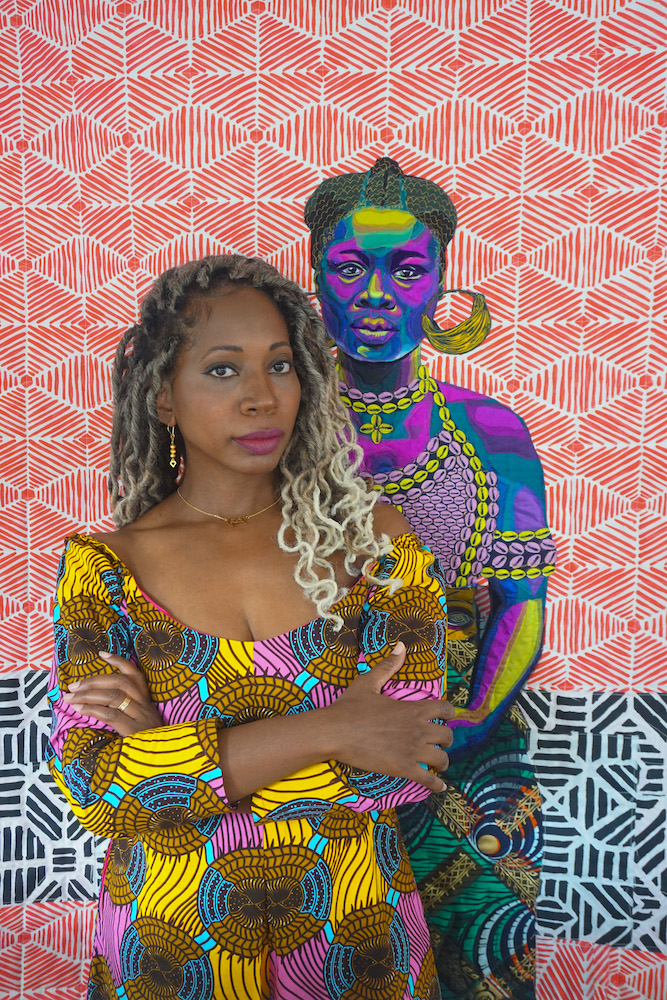 Portrait by John Butler
Portrait by John Butler
And then I made a quilt in grad school. It was a portrait of my grandmother, and that changed things for me. I realized I can sit on the sofa and you can have a kid crawling around, you are in a chair, and your little one can be at your knees. I know there are mothers who paint, but I don’t know how. So, I started quilting and it worked with my lifestyle.
WW: What kind of fabrics were you using?
BB: My mother and grandmother sewed clothing. My mother brought over containers of fabric. She was looking at Halston, Dior, Oscar de la Renta, and she would copy their designs and make them for herself or her sisters.
She was giving me the leftovers from her work, but also legacy. All those fabrics were dressmaker fabrics, not what quilters traditionally use. So I started making more portraits of family and friends. My grandmother also had all of her fabrics she put aside from the seventies—groovy flowers, orange and brown, and African fabric, too.
WW: Who were some of your first subjects?
BB: I made a portrait of my father’s father. I never met him, and he died in Africa from appendicitis in the early 1940s. They were farming people, not wealthy. There are no photos of him. It’s funny how generational pain can last. The family was so poor, they had to split up. My father went to boarding school. A benefactor paid for his schooling. Two of his sisters were married to the same man—they were 12 and 13. The family was devastated. So we grew up hearing that story about our grandfather and how the family was decimated after his passing.
I decided to make a portrait of what I thought he would look like. And I thought, “Why don’t I use all African fabric because he was an African man?” And because my grandmother’s fabrics were vintage, I thought this was perfect. He may have come into contact with these prints in his lifetime. I made that piece, and that took; it just was right. So now, when I make portraits, I use fabric that will tell the story of this person.
WW: Your recent show at Claire Oliver Gallery, “The Storm, the Whirlwind and the Earthquake,” was inspired by photographs taken of African Americans during World War II. How did you become interested in that archival material?
BB: It all started with wanting to recapture and know people who are gone and kind of lost, thinking about my grandfather, that loss and not knowing him, what he looked like, anything about him other than my father’s vague memory.
When I looked online, I found 40,000 images in the public archives, with no names or identifiers except for where the photo was taken. They were just sitting in these databases, metaphorically collecting dust. They were taken during World War II. The government commissioned photographers to go out and photograph the status of the Negro peoples during the war. That was the precursor to social programs like welfare, not enacted until the 1960s.
A lot of the images online weren’t printed; they weren’t seen at all. Aside from researchers and curious folks like me, they are not going to be seen. All these people deserve better.
WW: What kind of photographs caught your attention, and inspired you to make a piece with?
BB: I was looking, saving interesting images, and there was one of this little boy standing by a porch in Georgia in the 1940s. He had on overalls and a little cap. He has this grown-up look in his face, looking at the photographer, judging him, just as we’re judging him. He had no shoes, and I grappled with that. I want to portray him like he is, but I also don’t want him to be an object of pity. I work on these pieces for one hundred to two hundred hours. I do feel an emotional connection, almost like he’s my little boy now. What would he want?
So, when I did the piece, I gave him a really nice pair of Chucks. I thought, I’m going to put things on him that he would like, like a motorcycle man on his pocket. This is after World War II, so I know he’s seeing airplanes, so I put airplanes all over his overalls. On his shirt I put horses; he’s in the country, he sees horses.
He’s around eight in 1940, but when he’s a man, it’s going to be the sixties. He’s moving into this technological world. The things that he would see, what world is he coming into, his reality as an adult is going to be very different than where he is now as a child. It becomes this anthropological exercise of researching what was happening at the time but also me thinking about what I wish for this person to have.
WW: Why is that story important for you to tell?
BB: It’s this broader idea of the unknown Black people, ordinary people where something about their portrait captured me and I saw beauty and dignity in them. I don’t think I’m putting beauty or dignity in. I’m exposing it, revealing it. Everything is all perspective. None of us are neutral.
The African fabrics I’m using to give back, too. As African people transplanted in America, I want to give that heritage back. They have a legacy that was stolen from them. I want to give identity, history, and legacy back.
WW: What are you working on now?
BB: I’ve been thinking more now of those who have been passed over. We hear stories of Black people killed unjustly like Trayvon Martin and George Floyd. And I’m hearing constantly of all these other people who this has happened to and their stories didn’t make the news, didn’t make a big impact. Some photos I’m finding are from the forties and fifties, people who were hurt and killed and forgotten. My next series will include a lot of these people.
WW: You’ve talked about how your professors at Howard University, when you were an art student, instilled in you the responsibility of an artist—that you are a reflection of your time. How did that impact you?
BB: That whole responsibility piece was really big and it stemmed from the founding of HBCUs. Those who get to go to college are expected when they go home they should talk to their community about what they’re learning. You have a responsibility to spread what you learned with people who don’t have access.
In the arts program it was like that as well. Art can be so uplifting, and it can be educational. The arts faculty at Howard, a lot came from the Chicago school of thought AfriCOBRA. They were really radical in the sixties—you should be proud of your heritage, you don’t have to assimilate completely, you are not a darker-skinned white person. You can have your own identity.
Their mission was if you look at a piece of artwork it should be accessible, and when you look at it you should see that Black is beautiful. You should feel pride in being who you are. You still have a duty. As an artist, you can make your art, but you always have to be talking to your people. You don’t have the luxury to just do you. Your people are still suffering. I definitely connected with that.






